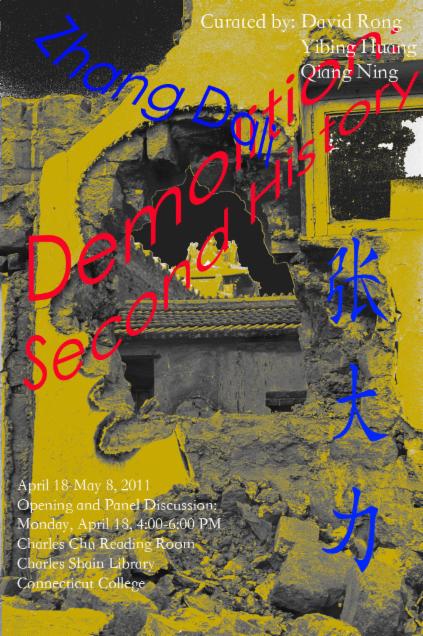DEMOLITION
DEMOLITION: SECOND HISTORY
4/15/11
FOR IMMEDIATE RELEASE
Contemporary Chinese artist Zhang Dali’s solo show, “Demolition: Second History,” opens on Monday April 18, 2011, at the Charles Chu Reading Room, Charles Shain Library, Connecticut College. There will be an opening reception and panel discussion from 4:00 to 6:00 pm.
Zhang Dali was born in Harbin in 1963 and graduated from the Central Academy of Fine Arts and Design in Beijing in 1987. From 1989 to 1995, he sojourned in Italy, where he discovered graffiti art. Returning to Beijing in 1995, he began the series “Dialogue and Demolition,” in which he spray-painted and carved his own profile on the walls of buildings condemned to demolition throughout Beijing. Zhang’s “Demolition” series provides a vivid record of China’s social reality and historical transformation at multiple, often conflicting levels, mimicking and also subverting both the physical and psychological violence caused by rapid social and historical transformation.
Since 2005, Zhang has turned his artistic attention to the doctored photographs produced by the People’s Republic of China that have become the most familiar images in the nation’s collective memory. According to Zhang, these photographs constitute a “second history.” Works from this “Second History” project have been collected in “China History Photograph Archive,” which bears Zhang Dali’s personal seal and has been exhibited in China, America, and Europe. In an interview conducted in New York on April 4 exclusively for this show, Zhang Dali observes: “Second history is also part of history. It is the distorted history, the altered history. [But] I think the second history is more real, and it more truthfully reflects the state of mind of this country.”
Most recently, Zhang has expanded his “Second History” project to other parts of the world, as well as extending its scope back to the birth of photography in the mid-nineteenth century. This new endeavor is comprised of 280 pieces in total, ranging from a doctored photograph of Lincoln to a fabricated FBI image of Osama bin Laden, more than doubling the size of the original project. This expanded collection has never been exhibited outside of China and has only been shown once in China itself. The current show debuts as the first official public appearance of this part of “Second History” in the West. In the recent interview mentioned above, Zhang Dali explains that both parts of “Second History” are intended primarily for a Chinese audience. Nonetheless, Zhang emphasizes that “power is the same all over the globe,” and thus these works have universal relevance.
In response to a question about the rise of contemporary China and the social role of contemporary Chinese art, Zhang Dali answers that “demolition is the process of reconstruction.” In “Demolition” and “Second History,” Zhang Dali is urging us to go back to the original starting point of such important questions as: Is the rise of contemporary China and contemporary Chinese art a given fact, or just another invented “myth”? If China is already changing the world, will the world change China? As Zhang states in his message to the exhibition’s viewers, “to see art is to see oneself.”
Zhang Dali has exhibited extensively at Chinese and international museums and galleries. He is currently holding another solo show, “Zhang Dali: New Slogan,” at the Eli Klein Gallery, New York (April 4 – May 8, 2011). Recent and upcoming group exhibitions include; “Zhang Dali: A Second History,” Les Rencontres d'Arles, 41st Edition (2010); “The Original Copy: Photography of a Sculpture, 1839 to Today,” MOMA, New York (2010); and The 54th Venice Biennale (June, 2011).
“Demolition: Second History” will be on view through May 8, 2011. Curators: David Rong, Mai Mang (Yibing Huang) and Qiang Ning. Co-sponsors: Art Next Gallery in New York and Connecticut College.
For more contact information: artnextgallery@gmail.com
_______________________________________________________________
“拆”与被“拆”的世界
-写在张大力的“第二历史展”之前
策展人:David Rong 荣伟
如果说1966年10月在美国霍普金斯大学召开的结构主义研讨会上,德里达发表了他那篇著名的后结构主义宣言:[人文科学中的结构、符号和游戏],标志着从此人类社会进入了一个“没有中心"的时代,或者说“消解中心”的时代。人类社会几千年来形成的“中心”意味着一个超验的“物自体”,“中心”是我们通过万象达到的“本质”,是我们认识真理的“主宰”。德里达与他同时代的其他思想家、理论家;福柯、巴特尔、拉康、克里斯蒂娃等开启了一个划时代的后结构主义或解构主义(Deconstructionism)时代。现象就是本质,“边缘”也是“中心”,任何“中心”是“独断论”的,也是“专断”蛮横的,是必须被“解构”或“消解”的。你阅读莎士比亚的[哈姆雷特]崇高经验不可以替代对斯里兰卡乡村诗人的审美体验,这早已经是当代“政治正确”文化核心。
但人类社会是否正进入了一个自己设定“悖论”或“陷阱”?在“消解中心”的同时也“消解”了自己,“本体论”的消除也意味着“主体意识”消亡,“中心”走向边缘,边缘却“了无边际”,“现象”对“本质”的代替最后的结局就是当代社会的“乱象众生”。世界实际上正进入一个“拆”或被“拆”的时代。可以说一部当代艺术史就是这样一部“拆”与被“拆”的历史的真实写照。安迪.沃荷的“可乐罐头”、“25个有色的玛丽莲.梦露像”代表了如当代著名思想家让.鲍德里亚所揭示的资本主义后工业消费社会的典型特征:“超真实”(Hyperreality )和“仿真实”(Simulation), 更见证了瓦尔特.本雅明的“机械时代的艺术复制品”对艺术的“唯一性”的颠覆。“拆”(Demolition)是对解构主义( Deconstructionism )的延续,抑或颠覆?
张大力在上个世纪九十年代末创作了他的系列作品[对话与拆],是对现实社会场境与历史变迁的描绘,更是对一种暴力社会与社会暴力的心理“拆解”。“拆”,乃至“强拆”,这已经成为中国社会经济发展在当今世界中的“奇观”。如果说AK47步枪的发明见证了人类在二十世纪最为广泛的对生命的杀戮,那么“拆”及“强拆”的出现,是否意味着要对人类文明的又一次“心理血洗”?“拆”是强暴的、必然的,被“拆”是无奈和无力的,然当艺术家的“拆”呈现出艺术的“超真实”(Hyperreality)和“仿真实”(Simulation),“拆”最终就有了对“拆”的“拆解”。
张大力的“拆”更多的是对现实社会强权对我们生存处境强暴的“颠覆”,那么他在
2006年开始推出的“第二历史”则更“拆”开了所谓“历史”对我们人类精神家园的“遮蔽”。历史学家汤因比曾经说过,研究历史可以增长我们的智慧,历史是维持人类生命所不可缺少的因素。然而当我们看到维基解密网站的出现,“历史”就成为了超越历史学家的“历史”,即超越“第一历史”的“第二历史”,抑或我们可以说人类正进入了一个“第二历史”时代?“历史”的发展仿佛又回到“原点”,当代历史并没有日本学者福山
所说的已经“终结”(End of History),连他本人都认为,“客观事实证明,西方自由民主可能并非人类历史进化的终点。随着中国崛起,所谓‘历史终结论’有待进一步推敲和完善。”(转引自日本[中央公论]20109月号刊登的福山演讲和对他的访谈[日本要直面中国世纪] )这难道就是黑格尔乃至马克思所信奉的“历史的螺旋线性”发展逻辑吗?当代中国的崛起,是我们这个日益堕落的世界的“救星”,抑或只是当代世界艺术创造的虚拟的“神话”?“中国走向世界或世界走向中国”这个当年中国知识界喋喋不休的话题,如今却成为了当今世界“显学”。中国已经或正在改变世界,世界能否改变中国? 中国与世界,使得“拆”与被“拆”已成为当今世界的最为奇特的“景观”。有一点可以是毫无疑义,当代中国已经成为一段开启“第二历史”的原点。张大力的个展“拆:第二历史”,就是让我们回到“第二历史”的原点。
张大力的“拆:第二历史”美国巡回展,将于2011年4月18日星期一在康州学院查尔斯.宪恩图书馆开幕,策展人:David Rong(荣伟)、Mai Mang(黄亦兵)Qiang Ning( 宁强)。本展览将在美国大学作巡回展,2011年6月将在纽约杭特学院展出。